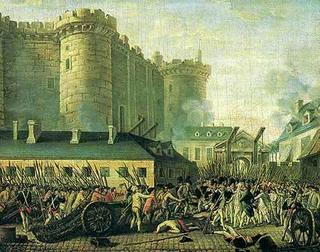Fall of the Bastille


1789 French Revolution: Parisians stormed the Bastille Prison in Paris and freed seven political prisoners.
When the revolutionary mob stormed the French prison they were surprised to find most of the cells empty but for the miserable scratchings of prisoners on the walls.
Only seven prisoners were resident, under the relatively (for his time) lenient penal policies of King Louis XVI (1754 - 1793). Among those inmates, Marquis de Sade (1740 - 1814) is believed to have triggered the assault by crying that people were being executed inside.
Three of the prisoners were old men, legitimately incarcerated; two of these had become insane, no doubt because of the horrible conditions in the cells. The other four prisoners had been in the Bastille for only four years each, for various crimes such as forgery. The seven were paraded through the streets as heroes, though the revolutionaries must have been disappointed that they did not have more to show off.
The Man in the Iron Mask
It was widely believed at the time and for years afterwards, that the wasted body of the celebrated Man in the Iron Mask had been found there, with the dreadful mask still on his skull.
Held for over forty years in prison [the 19th Century folklorist Robert Chambers says only the last five years of his imprisonment were actually in Bastille] during the reign of King Louis XVI, the Man in the Iron Mask was an unknown prisoner. When travelling from prison to prison, he always wore a mask of velvet, not iron. He was buried as ‘M. de Marchiel’, but his true identity has never been revealed. One suggestion was that he was the Duc de Vermandois, an illegitimate son of Louis XVI.
Alexandre Dumas in his romantic novel suggested that he was an illegitimate elder brother of the king, with Cardinal Mazarin his father – a suggestion originally made by Voltaire.
Lord Acton, the British historian, suggested a minister of the Duke of Mantua, who, in his negotiations with the king, was found to be treacherous and imprisoned at Pignerol.
Whenever he was moved, he was disguised with a velvet and whalebone mask, though it entered the popular imagination that this mysterious, unknown character, was masked with iron. Whoever this mystery man was, he apparently died on November 19, 1703; his dungeon was scraped to the stone, and his doors and windows burned, lest any inscribed message get out to the world and thus reveal his identity, and Louis’s great cruelty to the representative of another state.







0 Comments:
Post a Comment
<< Home